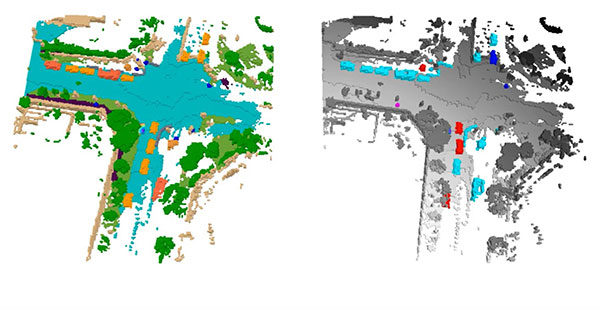NVIDIA Research Wins Autonomous Driving Challenge
New work introduces 3D occupancy prediction for safe self-driving systems.

3D occupancy prediction is the process of forecasting the status of each voxel in a scene, that is, each data point on a 3D bird’s-eye-view grid. Image courtesy of NVIDIA.
Latest News
June 20, 2023
NVIDIA will be showcased next week as the winner of the 3D Occupancy Prediction Challenge for autonomous driving development at the Computer Vision and Pattern Recognition Conference (CVPR), in Vancouver, Canada.
The competition had more than 400 submissions from nearly 150 teams across 10 regions.
3D occupancy prediction is the process of forecasting the status of each voxel in a scene, that is, each data point on a 3D bird’s-eye-view grid. Voxels can be identified as free, occupied or unknown.
Critical to the development of safe self-driving systems, 3D occupancy grid prediction provides information to autonomous vehicle (AV) planning and control stacks using neural networks and transformer models, which are enabled by the NVIDIA DRIVEplatform.
“NVIDIA’s winning solution features two important AV advancements,” says Zhiding Yu, senior research scientist for learning and perception at NVIDIA. “It demonstrates a state-of-the-art model design that yields excellent bird’s-eye-view perception. It also shows the effectiveness of visual foundation models with up to 1 billion parameters and large-scale pretraining in 3D occupancy prediction.”
Perception for autonomous driving has evolved over the past years from handling 2D tasks, such as detecting objects or free spaces in images, to reasoning about the world in 3D with multiple input images.
This provides a flexible and precise fine-grained representation of objects in complex traffic scenes, which is “critical for achieving the safety perception requirements for autonomous driving,” according to Jose Alvarez, director of AV applied research and distinguished scientist at NVIDIA.
In addition to winning first place in the challenge, NVIDIA will receive at the event an Innovation Award, recognizing its “fresh insights into the development of view transformation modules,” with “substantially improved performance” compared to previous approaches, according to the CVPR workshop committee.
Read NVIDIA’s technical report on the submission.
Sources: Press materials received from the company and additional information gleaned from the company’s website.
More NVIDIA Coverage
Subscribe to our FREE magazine, FREE email newsletters or both!
Latest News
About the Author
DE’s editors contribute news and new product announcements to Digital Engineering.
Press releases may be sent to them via [email protected].






